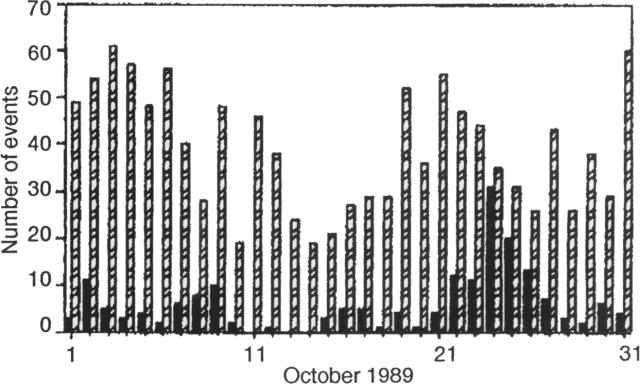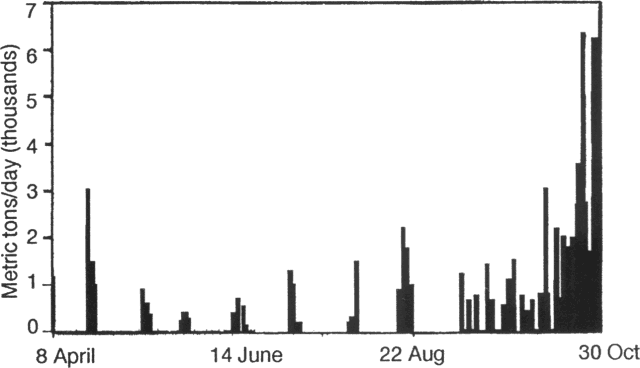Report on Galeras (Colombia) — October 1989
Scientific Event Alert Network Bulletin, vol. 14, no. 10 (October 1989)
Managing Editor: Lindsay McClelland.
Galeras (Colombia) Seismic activity remains strong; high SO2
Please cite this report as:
Global Volcanism Program, 1989. Report on Galeras (Colombia) (McClelland, L., ed.). Scientific Event Alert Network Bulletin, 14:10. Smithsonian Institution. https://doi.org/10.5479/si.GVP.SEAN198910-351080
Galeras
Colombia
1.22°N, 77.37°W; summit elev. 4276 m
All times are local (unless otherwise noted)
Seismicity remained stable during October, except for a brief decline at mid-month. Low-frequency events averaged ~40/day, while high-frequency events averaged 6/day, with 31 recorded on the 24th (figure 11). About 13 pulses of spasmodic tremor were recorded each day over nearly continuous background tremor.
 |
Figure 11. Daily number of low-frequency (cross-hatched bars) and high-frequency (solid bars) events at Galeras, October 1989. Courtesy of the Observatorio Vulcanológico de Colombia. |
Aerial and field inspections showed little change in fumarolic emissions from previous months. The most active area, on the SW slope of the central cone, was surrounded by abundant sulfur deposits and emitted high-temperature gases. Incandescence was periodically observed. During the last week of October, SO2 emissions were the highest since COSPEC monitoring began in April 1988 (figure 12). Although electronic tilt varied slightly, EDM and dry tilt measurements showed no significant changes.
 |
Figure 12. Daily rates of SO2 emissions (in metric tons/day) measured by COSPEC at Galeras, 5 April-October 1989. Courtesy of the Observatorio Vulcanológico de Colombia. |
Geological Summary. Galeras, a stratovolcano with a large breached caldera located immediately west of the city of Pasto, is one of Colombia's most frequently active volcanoes. The dominantly andesitic complex has been active for more than 1 million years, and two major caldera collapse eruptions took place during the late Pleistocene. Long-term extensive hydrothermal alteration has contributed to large-scale edifice collapse on at least three occasions, producing debris avalanches that swept to the west and left a large open caldera inside which the modern cone has been constructed. Major explosive eruptions since the mid-Holocene have produced widespread tephra deposits and pyroclastic flows that swept all but the southern flanks. A central cone slightly lower than the caldera rim has been the site of numerous small-to-moderate eruptions since the time of the Spanish conquistadors.
Information Contacts: C. Carvajal, INGEOMINAS, Pasto.

